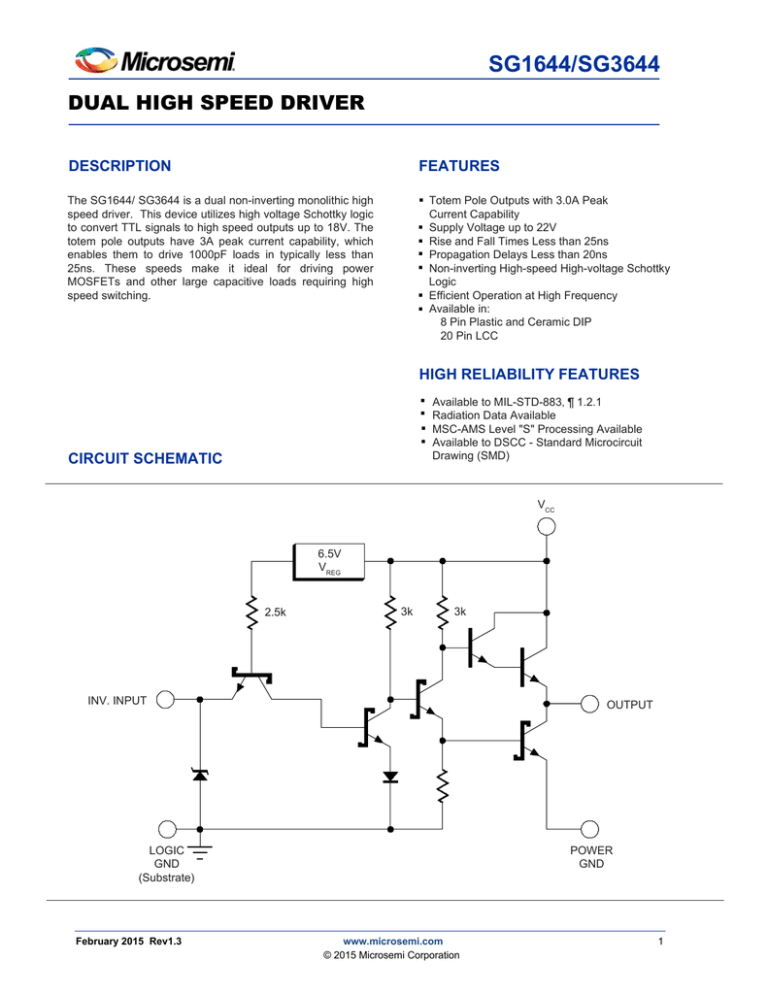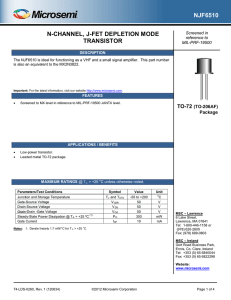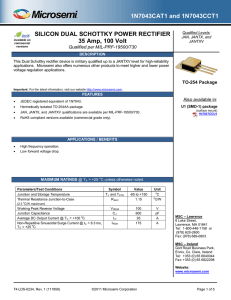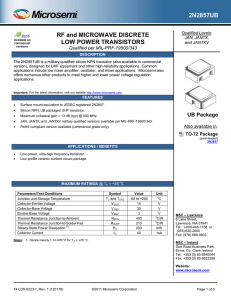
SG1644/SG3644
DUAL HIGH SPEED DRIVER
DESCRIPTION
FEATURES
The SG1644/ SG3644 is a dual non-inverting monolithic high
speed driver. This device utilizes high voltage Schottky logic
to convert TTL signals to high speed outputs up to 18V. The
totem pole outputs have 3A peak current capability, which
enables them to drive 1000pF loads in typically less than
25ns. These speeds make it ideal for driving power
MOSFETs and other large capacitive loads requiring high
speed switching.
Totem Pole Outputs with 3.0A Peak
Current Capability
Supply Voltage up to 22V
Rise and Fall Times Less than 25ns
Propagation Delays Less than 20ns
Non-inverting High-speed High-voltage Schottky
Logic
Efficient Operation at High Frequency
Available in:
8 Pin Plastic and Ceramic DIP
20 Pin LCC
HIGH RELIABILITY FEATURES
CIRCUIT SCHEMATIC
Available to MIL-STD-883, ¶ 1.2.1
Radiation Data Available
MSC-AMS Level "S" Processing Available
Available to DSCC - Standard Microcircuit
Drawing (SMD)
VCC
6.5V
VREG
2.5k
3k
3k
INV. INPUT
OUTPUT
LOGIC
GND
(Substrate)
February 2015 Rev1.3
POWER
GND
www.microsemi.com
© 2015 Microsemi Corporation
1
ABSOLUTE MAXIMUM RATINGS
(Note 1)
Supply Voltage (VCC) ........................................................... 22V
Logic Input Voltage ............................................................... 7V
Source/Sink Output Current (Each Output)
Continuous ................................................................... ±0.5A
Pulse, 500ns ................................................................ ±3.0A
Operating Junction Temperature
Hermetic (Y-Package) ................................................. 150°C
Plastic (M, L-Packages) .............................................. 150°C
Storage Temperature Range ............................ -65°C to 150°C
Lead Temperature (Soldering, 10 Seconds) .................. 300°C
Note 1. Exceeding these ratings could cause damage to the device. All
voltages are with respect to ground. All currents are positive into the
specified terminal.
Note 2. RoHS Peak Package Solder Reflow Temp. (40 sec. max. exp.)
260°C (+0, -5)
THERMAL DATA
Y Package:
Thermal Resistance-Junction to Case, θJC .................. 50°C/W
Thermal Resistance-Junction to Ambient, θ JA ............. 130°C/W
M Package:
Thermal Resistance-Junction to Case, θ JC .................. 60°C/W
Thermal Resistance-Junction to Ambient, θ JA .............. 95°C/W
L Package:
Thermal Resistance-Junction to Case, θJC .................. 35°C/W
Thermal Resistance-Junction to Ambient, θJA ............ 120°C/W
Note A. Junction Temperature Calculation: TJ = TA + (PD x θJA).
Note B. The above numbers for θJC are maximum for the limiting thermal resistance of the package in a standard mounting
configuration. The θJA numbers are meant to be guidelines for the thermal performance of the device/pc-board system. All of the above
assume no ambient airflow.
RECOMMENDED OPERATING CONDITIONS
(Note 2)
Supply Voltage (VCC) .................................. 4.5V to 20V (Note 3)
Frequency Range ............................................... DC to 1.5MHz
Peak Pulse Current ............................................................ ±3A
Logic Input Voltage ................................................. -0.5 to 5.5V
Operating Ambient Temperature Range (TA)
SG1644 ......................................................... -55°C to 125°C
SG3644 ............................................................... 0°C to 70°C
Note 2. Range over which the device is functional.
Note 3. AC performance has been optimized for VCC = 8V to 20V.
ELECTRICAL CHARACTERISTICS
(Unless otherwise specified, these specifications apply over the operating ambient temperatures for SG1644 with -55°C ≤ TA ≤ 125°C, SG3644 with
0°C ≤ T A ≤ 70°C, and VCC = 20V. Low duty cycle pulse testing techniques are used which maintains junction and case temperatures equal to the
ambient temperature.)
Parameter
Static Characteristics
Logic 1 Input Voltage
Logic 0 Input Voltage
Input High Current
Input High Current
Input Low Current
Input Clamp Voltage
Output High Voltage (Note 4)
Output Low Voltage (Note 4)
Supply Current Outputs Low
Supply Current Outputs High
Test Conditions
SG1644/SG3644
Min. Typ. Max.
2.0
VIN = 2.4V
VIN = 5.5V
VIN = 0V
IIN = -10mA
IOUT = -200mA
IOUT = 200mA
VIN = 0V (both inputs)
VIN = 2.4V (both inputs)
Note 4. VCC = 10V to 20V.
2
0.7
500
1.0
-4
-1.5
VCC-3
18
7.5
1.0
27
12
Units
V
V
µA
mA
mA
V
V
V
mA
mA
ELECTRICAL CHARACTERISTICS
Parameter
(continued)
Test Conditions (Figure 1)
Dynamic Characteristics (Note 6)
Propagation Delay High-Low
(TPHL)
Propagation Delay Low-High
(TPLH)
Rise Time (TTLH)
Fall Time (TTHL)
Supply Current (ICC)
(both outputs)
CL = 1000pF (Note 5)
CL = 2500pF
CL = 1000pF (Note 5)
CL = 2500pF
CL = 1000pF (Note 5)
CL = 2500pF
CL = 1000pF (Note 5)
CL = 2500pF
CL = 2500pF, Freq. = 200kHz
Duty Cycle = 50%
SG1644/SG3644
TA= 25°C
Min. Typ. Max.
26
18
30
30
30
SG1644
TA=-55°°C to 125°°C
Min. Typ. Max.
30
35
25
30
30
40
25
40
35
40
50
30
40
35
50
30
50
40
Units
ns
ns
ns
ns
ns
ns
ns
ns
mA
Note 5. These parameters, specified at 1000pF, although guaranteed over recommended operating conditions, are not tested in production.
Note 6. VCC = 15V.
AC TEST CIRCUIT AND SWITCHING TIME WAVEFORMS
200kHz
1k
CHARACTERISTIC CURVES
Freq = 200kHz
Freq = 200kHz
Freq = 200kHz
FIGURE 2.
TRANSITION TIMES VS. SUPPLY VOLTAGE
FIGURE 3.
PROPAGATION DELAY VS. SUPPLY VOLTAGE
3
FIGURE 4.
TRANSITION TIMES VS. AMBIENT TEMPERATURE
CHARACTERISTIC CURVES
(continued)
Freq = 200kHz
Freq = 200kHz
Freq = 200kHz
FIGURE 5.
PROPAGATION DELAY VS. AMBIENT TEMPERATURE
FIGURE 6.
TRANSITION TIMES VS. CAPACITIVE LOAD
FIGURE 7.
SUPPLY CURRENT VS. CAPACITANCE LOAD
10k
FIGURE 8.
HIGH SIDE SATURATION VS. OUTPUT CURRENT
FIGURE 9.
LOW SIDE SATURATION VS. OUTPUT CURRENT
10k
100k
FIGURE 11.
SUPPLY CURRENT VS. FREQUENCY
4
100k
FIGURE 10.
SUPPLY CURRENT VS. FREQUENCY
APPLICATION INFORMATION
POWER DISSIPATION
The SG1644, while more energy-efficient than earlier gold-doped
driver IC’s, can still dissipate considerable power because of its
high peak current capability at high frequencies. Total power
dissipation in any specific application will be the sum of the DC or
steady-state power dissipation, and the AC dissipation caused by
driving capacitive loads.
tantalum capacitor for energy storage. In military applications, a
CK05 or CK06 ceramic operator with a CSR-13 tantalum capacitor is an effective combination. For commercial applications, any
low-inductance ceramic disk capacitor teamed with a Sprague
150D or equivalent low ESR capacitor will work well. The
capacitors must be located as close as physically possible to the
VCC pin, with combined lead and pc board trace lengths held to
less than 0.5 inches.
The DC power dissipation is given by:
GROUNDING CONSIDERATIONS
PDC = +VCC · ICC [1]
The ability of the SG1644 to deliver high peak currents into
capacitive loads can cause undesirable negative transients on
the logic and power grounds. To avoid this, a low inductance
ground path should be considered for each output to return the
high peak currents back to its own ground point. A ground plane
is recommended for best performance. If space for a ground
plane is not available, make the paths as short and as wide as
possible. The logic ground can be returned to the supply
bypass capacitor and be connected at one point to the power
grounds.
where ICC is a function of the driver state, and hence is duty-cycle
dependent.
The AC power dissipation is proportional to the switching frequency, the load capacitance, and the square of the output
voltage. In most applications, the driver is constantly changing
state, and the AC contribution becomes dominant when the
frequency exceeds 100-200kHz.
LOGIC INTERFACE
The SG1644 driver family is available in a variety of packages to
accommodate a wide range of operating temperatures and power
dissipation requirements. The Absolute Maximums section of the
data sheet includes two graphs to aid the designer in choosing an
appropriate package for his design.
The logic input of the 1644 is designed to accept standard DCcoupled 5 volt logic swings, with no speed-up capacitors required.
If the input signal voltage exceeds 6 volts, the input pin must be
protected against the excessive voltage in the HIGH state. Either
a high speed blocking diode must be used, or a resistive divider
to attenuate the logic swing is necessary.
The designer should first determine the actual power dissipation
of the driver by referring to the curves in the data sheet relating
operating current to supply voltage, switching frequency, and
capacitive load. These curves were generated from data taken
on actual devices. The designer can then refer to the Absolute
Maximum Thermal Data section to choose a package type, and
to determine if heat-sinking is required.
LAYOUT FOR HIGH SPEED
The SG1644 can generate relatively large voltage excursions
with rise and fall times around 20-30 nanoseconds with light
capacitive loads. A Fourier analysis of these time domain signals
will indicate strong energy components at frequencies much
higher than the basic switching frequency. These high frequencies can induce ringing on an otherwise ideal pulse if sufficient
inductance occurs in the signal path (either the positive signal
trace or the ground return). Overshoot on the rising edge is
undesirable because the excess drive voltage could rupture the
gate oxide of a power MOSFET. Trailing edge undershoot is
dangerous because the negative voltage excursion can
forward-bias the parasitic PN substrate diode of the driver,
potentially causing erratic operation or outright failure.
DESIGN EXAMPLE
Given: Two 2500pF loads must be driven push-pull from a
+15 volt supply at 100kHz. The application is a commercial one
in which the maximum ambient temperature is +50°C, and cost
is important.
1. From Figure 11, the average driver current consumption
under these conditions will be 18mA, and the power dissipation
will be 15volts x 18mA, or 270mW.
Ringing can be reduced or eliminated by minimizing signal path
inductance, and by using a damping resistor between the drive
output and the capacitive load. Inductance can be reduced by
keeping trace lengths short, trace widths wide, and by using 2oz.
copper if possible. The resistor value for critical damping can be
calculated from:
2. From the thermal data table the M package provides a
95°C/W temperature rise junction to ambient. Therefore
270mW multiplied by 95°C/W calculates to a temperature rise
of about 26°C. The M package has therefore enough thermal
conduction to support operation at +50°C. The SG3644M driver
would be specified for this application.
RD = 2√L/CL [2]
SUPPLY BYPASSING
where L is the total signal line inductance, and CL is the load
capacitance. Values between 10 and 100ohms are usually
sufficient. Inexpensive carbon composition resistors are best
because they have excellent high frequency characteristics.
They should be located as close as possible to the gate terminal
of the power MOSFET.
Since the SG1644 can deliver peak currents above 3amps under
some load conditions, adequate supply bypassing is essential for
proper operation. Two capacitors in parallel are recommended to
guarantee low supply impedance over a wide bandwidth: a 0.1µF
ceramic disk capacitor for high frequencies, and a 4.7µF solid
5
TYPICAL APPLICATIONS
FIGURE 12.
In this push pull converter circuit, the control capabilities of the SG1524B PWM are combined with the powerful totem-pole
drivers found in the SG1644 (see SG1626 for example). This inexpensive configuration results in very fast charge and
discharge of the power MOSFET gate capacitance for efficient switching.
FIGURE 13.
When the peak current capabilities of PWM's such as 1525A or 1526B are not sufficient to drive high capacitive loads fast enough,
SG1644 is one solution to this problem. This combination is especially suited for full bridge applications where high input
capacitance MOSFETs are being used. Diodes D1 and D2 are necessary if the leakage inductance of the drive transformer will
drive the output pins negative.
6
TYPICAL APPLICATIONS
(continued)
FIGURE 14.
A low cost, yet powerful alternative to the single ended converters with parallel MOSFETs is a combination of SG1842 and SG1644
as shown in Figure 16. This combination will also allow a low noise operation by separating the drive and its associated high peak
currents, away from the PWM logic section.
FIGURE 16.
When the inputs are driven with a TTL square wave drive, the
high peak current capabilities of SG1644 allow easy implementation of charge pump voltage converters.
FIGURE 15.
Fast turn off of bipolar transistors is possible by the totem
pole output stage of SG1644. The charge on capacitor C will
drive the base negative for faster turn off.
7
CONNECTION DIAGRAMS & ORDERING INFORMATION
Package
8-PIN CERAMIC DIP
Y - PACKAGE
Part No.
SG1644Y-883B
SG1644Y-DESC
SG1644Y
8-PIN PLASTIC DIP
M - PACKAGE
SG3644M
20-PIN CERAMIC (LCC)
LEADLESS CHIP CARRIER
L- PACKAGE
SG1644L-883B
SG1644L-DESC
(See Notes Below)
Ambient
Temperature Range
Connection Diagram
-55°C to 125°C
-55°C to 125°C
-55°C to 125°C
0°C to 70°C
-55°C to 125°C
-55°C to 125°C
IN A
PWR GND A
1
8
2
7
VCC
PWR GND B
IN B
3
6
4
5
LOGIC GND
OUT B
OUT A
M Package: RoHS Compliant / Pb-free Transition DC: 0503
M Package: RoHS / Pb-free 100% Matte Tin Lead Finish
1.
2.
3.
4.
5.
6.
7.
8.
9.
10.
N.C.
PWR GND A
N.C.
IN A
N.C.
LOGIC GND
N.C.
IN B
N.C.
PWR GND B
3
2
1
20 19
4
18
5
17
6
16
7
15
8
14
9
10 11 12 13
Note 1. Contact factory for DESC product availability.
Note 2. All packages are viewed from the top.
Note 3. Hermetic Packages Y and L use Pb37/Sn63 hot solder lead finish, contact factory for availability of RoHS versions.
8
11.
12.
13.
14.
15.
16.
17.
18.
19.
20.
N.C.
N.C.
OUT B
N.C.
VCC
N.C.
VCC
N.C.
OUT A
N.C.
PACKAGE OUTLINE DIMENSIONS
Controlling dimensions are in inches, metric equivalents are shown for general information.
Dim
D
5
8
E
11
4
A
Q
b
4.32
5.08
0.170
0.200
b
0.38
0.51
0.015
0.020
b2
1.04
1.65
0.045
0.065
c
0.20
0.38
0.008
0.015
D
9.52
10.29
0.375
0.405
E
5.59
7.11
0.220
0.280
2.54 BSC
0.100 BSC
eA
7.37
7.87
0.290
0.310
H
0.63
1.78
0.025
0.070
L
3.18
4.06
0.125
0.160
α
-
15°
-
15°
Q
0.51
1.02
0.020
0.040
Note:
α
SEATING
PLANE
e
H
c
L
INCHES
MIN
MAX
A
e
eA
b2
MILLIMETERS
MIN
MAX
Dimensions do not include protrusions; these shall not
exceed 0.155mm (.006”) on any side. Lead dimension shall
not include solder coverage.
Figure 17 · Y 8-Pin CERDIP Package Dimensions
Dim
D
A
A2
b
b2
c
D
E
e
E1
L
θ
E1
1
b2
A2
E
A
L
H
-
5.08
3.30 Typ.
0.38
0.51
0.76
1.65
0.20
0.38
10.16
7.62 BSC
2.54 BSC
6.10
6.86
3.05
0°
15°
INCHES
MIN
MAX
-
0.200
1.30 Typ.
0.145
0.020
0.030
0.065
0.008
0.015
0.400
0.300 BSC
0.100 BSC
0.240
0.270
0.120
0°
15°
c
Note:
θ
e
MILLIMETERS
MIN
MAX
Dimensions do not include mold flash or protrusions; these
shall not exceed 0.155mm (.006”) on any side. Lead
dimension shall not include solder coverage.
b
Figure 18 · M 8-Pin PDIP Package Dimensions
9
PACKAGE OUTLINE DIMENSIONS (continued)
E3
D
Dim
D/E
E3
E
e
B1
A
A1
L2
8.64
9.14
0.340
0.360
-
8.128
-
0.320
1.270 BSC
0.635 TYP
0.025 TYP
1.52
0.040
0.060
A
1.626
2.286
0.064
0.090
1.016 TYP
1.372
1.68
A2
-
L2
1.91
B3
0.040 TYP
0.054
0.066
1.168
-
0.046
2.41
0.075
0.95
0.203R
0.008R
Note: All exposed metalized area shall be gold plated
1
60 µ-inch minimum thickness over nickel plated
unless otherwise specified in purchase order.
13
h
A2
0.050 BSC
1.02
A1
3
INCHES
MIN
MAX
L
h
L
8
MILLIMETERS
MIN
MAX
18
B1
e
B3
Figure 19 · L 20-Pin Ceramic LCC Package Dimensions
10
Microsemi Corporation (Nasdaq: MSCC) offers a comprehensive portfolio of semiconductor
and system solutions for communications, defense & security, aerospace and industrial
markets. Products include high-performance and radiation-hardened analog mixed-signal
integrated circuits, FPGAs, SoCs and ASICs; power management products; timing and
synchronization devices and precise time solutions, setting the world’s standard for time; voice
processing devices; RF solutions; discrete components; security technologies and scalable
anti-tamper products; Power-over-Ethernet ICs and midspans; as well as custom design
capabilities and services. Microsemi is headquartered in Aliso Viejo, Calif., and has
approximately 3,400 employees globally. Learn more at www.microsemi.com.
Microsemi Corporate Headquarters
One Enterprise, Aliso Viejo,
CA 92656 USA
Within the USA: +1 (800) 713-4113
Outside the USA: +1 (949) 380-6100
Sales: +1 (949) 380-6136
Fax: +1 (949) 215-4996
E-mail: sales.support@microsemi.com
© 2015 Microsemi Corporation. All
rights reserved. Microsemi and the
Microsemi logo are trademarks of
Microsemi Corporation. All other
trademarks and service marks are the
property of their respective owners.
Microsemi makes no warranty, representation, or guarantee regarding the information contained herein or
the suitability of its products and services for any particular purpose, nor does Microsemi assume any
liability whatsoever arising out of the application or use of any product or circuit. The products sold
hereunder and any other products sold by Microsemi have been subject to limited testing and should not
be used in conjunction with mission-critical equipment or applications. Any performance specifications are
believed to be reliable but are not verified, and Buyer must conduct and complete all performance and
other testing of the products, alone and together with, or installed in, any end-products. Buyer shall not rely
on any data and performance specifications or parameters provided by Microsemi. It is the Buyer's
responsibility to independently determine suitability of any products and to test and verify the same. The
information provided by Microsemi hereunder is provided "as is, where is" and with all faults, and the entire
risk associated with such information is entirely with the Buyer. Microsemi does not grant, explicitly or
implicitly, to any party any patent rights, licenses, or any other IP rights, whether with regard to such
information itself or anything described by such information. Information provided in this document is
proprietary to Microsemi, and Microsemi reserves the right to make any changes to the information in this
document or to any products and services at any time without notice.
SG1644-1.3/02.15






